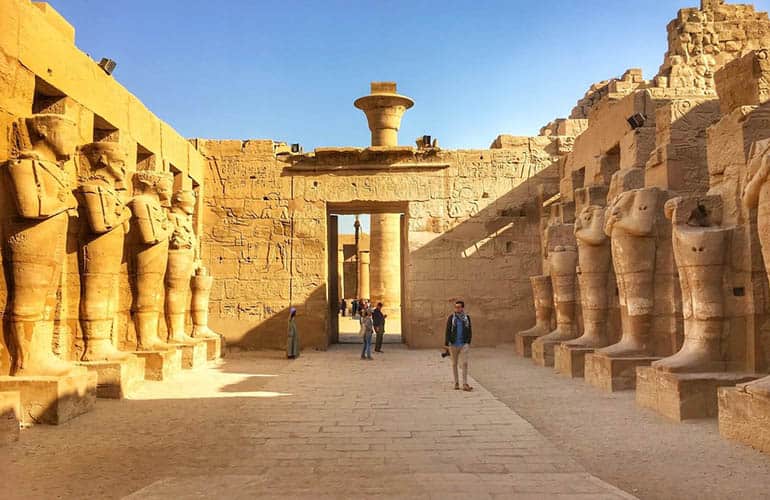Luxor is a city in Upper Egypt that includes the site of the Ancient Egyptian city of Thebes. It is known as the world's greatest open-air museum, home to some of Egypt's most famous temples, tombs, and monuments.
Luxor has been known by many names throughout its history, including Thebes, Waset, Ta ipet, and the "city of 100 gates." The name Luxor comes from the Arabic word for "palaces."
Luxor began to gain importance around 3000 BCE and eventually became Ancient Egypt's political, military, and religious capital for over 1500 years. Today,
Luxor is an important tourism center and is home to an incomparable number of ancient Egyptian monuments, including the Luxor Temple, Karnak Temple Complex, the necropolises of the Valley of the Kings and the Valley of the Queens, and the massive stone statues known as the Colossi of Menmon. Luxor is a small city that visitors can easily get around by taxi or horse-drawn carriage.
The city has a population of over half a million people who depend almost entirely on tourism. The climate in Luxor is quite sunny and hot, with average temperatures of 40 C (104 F) in the summer.
what is the best time of year to visit Luxor?
The best time to visit Luxor, Egypt is between March to April and between October to November.
These months offer pleasant temperatures, small crowds, and more affordable hotel rates.
Luxor's autumn season, from September through November, is another ideal time to visit, as the area's notoriously hot summer temperatures have started to drop, while the city's peak tourism season has yet to arrive.
During these periods, visitors can enjoy comfortable sightseeing temperatures that sit in the mid-50s to mid-90s[4]. Spring season, from March through May, marks warm weather in Luxor city, and despite hot weather, visitors can still enjoy the cheapest hotel and airfare rates during that season with minimal crowds.
However, visitors should be prepared for hot weather by bringing necessary items like a hat, sunblock, sunglasses, light clothes, suitable footwear, and drinking lots of water.It is recommended to arrange tours to be either in the very early morning or after sunset to avoid Luxor's intense heat.
Luxor's coolest temperatures can be enjoyed in winter, but visitors will also find hordes of tourists and high prices during this season. Between May and September, daytime temperatures typically climb into the 100s, which can make exploring Luxor's outdoor attractions exhausting and unbearable.
Attractions in Luxor
Luxor, Egypt, is known for its rich history and numerous attractions. Some of the top attractions in Luxor include:
1. Amun Temple Enclosure: A stunning temple built by the New Kingdom pharaohs Amenhotep III and Ramses II.
2. Valley of the Kings: A royal necropolis located on the west bank of the Nile River, containing the tombs of many pharaohs and nobles.
3. Karnak: An extraordinary complex of sanctuaries, kiosks, and temples dedicated to the god Amun-Ra.
4. Tomb of Tutankhamun (KV 62): The famous tomb of the boy king, discovered by Howard Carter in 1922.
5. Tomb of Ramses VI (KV 9): One of the most spectacular tombs in the Valley of the Kings, with broad corridors, long shafts, and a variety of decoration.
6. Tombs of the Nobles: Over 400 tombs on the west bank, some of the best least-visited attractions in Luxor.
7. Tomb of Sennofer & Rekhmire: Interesting parts of the tomb of Sennofer, overseer of the Garden of Amun under Amenhotep III.
8. Temple of Hatshepsut at Deir Al Bahri: A memorial temple built by Hatshepsut, featuring a unique design and stunning views of the rugged limestone cliffs.
9. Luxor Museum: A museum showcasing mummies and artifacts from ancient Egypt.
10. Mummification Museum: A museum dedicated to the process of mummification in ancient Egypt.
11. Colossi of Memnon: Two massive stone statues of Pharaoh Amenhotep III, located near the Temple of Luxor.
12. Avenue of the Rams: A street lined with sphinxes and other ancient statues, leading to the Temple of Luxor.
13. Queen's Island: A small island in the Nile River, home to the Temple of Hathor and other ancient ruins.
To explore these attractions, you can
contact us at Pioneer Tours We will provide a tour guide, comfortable transportation, and also book a hotel accommodation .
Some popular tour operators in Luxor include Memphis Tours and Love Egypt Tours, which offer private tour guides with backgrounds in Egyptian history.


